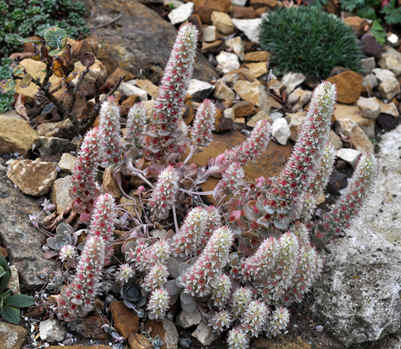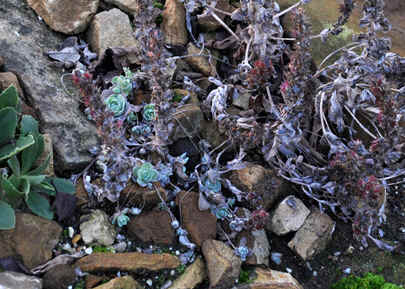|
Contents of the Spring 2012 Northants News
|
Orostachys
|
|
 |
Last
August I was lucky enough to visit the Manchester BCSS branch to give a
talk. On the evening they have a mini-show judged by their members. There
in the class for plants from the Crassula family I was able to see some Orostachys that were entirely new to me and very appealing.
I did some internet research on the names on my return but there was
little more information beyond that these were selections of long named
species. They are on my wish list in case you want to trade. Shortly
after I went to the Oxford BCSS branch where I gave a talk on the Crassula
family and invited members to bring interesting plants. John Watmough
certainly brought one that had me rushing for my camera. He had it
labelled Orostachys ‘Hou-ou’ and explained that the name was
derived from the sound made by ghosts in Japanese. A web search showed
that the more accepted name is ‘Houou’ which is not so clear. Under
the main rosettes were many small rosettes and I was able to scrounge a
couple. They quickly rooted and fingers crossed we will be able to
perpetrate this interesting plant in NN country. As we proceeded into autumn there was a pronounced change in my plants of Orostachys boehmeri. The rosettes began to elongate into a flowering stems (left). Soon every single rosette was flowering, even the small ones. A fortnight later and the flower stems had turned from white to red and a close inspection showed that this was due to the formation of red fruits. At this stage there were just a few minute rosettes that were not flowering so maybe some hope for the future. In nature I am sure these fruit capsules would be sending minute Crassulacean seeds off into the wind to colonise new rocky outcrops. However the original plant transferred to the greenhouse (as insurance?) had flowered itself to death. Oh, well… But now in March I see that there are still a few minute rosettes to resurrect the plant (left). |
 |
|
|
|
|
|
Three
Orostachys at the Manchester Show Left:
Orostachys
sp Haman, S. Korea
Centre: Orostachys
sp Pocheon, S. Korea
Right:
Orostachys
sp Kumdang, S. Korea |
||
If
you can draw any conclusions from this we infer that Orostachys can be easy to grow and they can be tricky…
Probably they require much more water than many succulents we grow – in the
garden they get it but we must remember them in the greenhouse or cold-frame.
And we should always take some cuttings/offsets as hostages to fortune. Finally,
as they pass into the flower-themselves-to-death-phase that last sentence must apply. Take some cutting or non-flowering offsets; no matter how small.
Trev